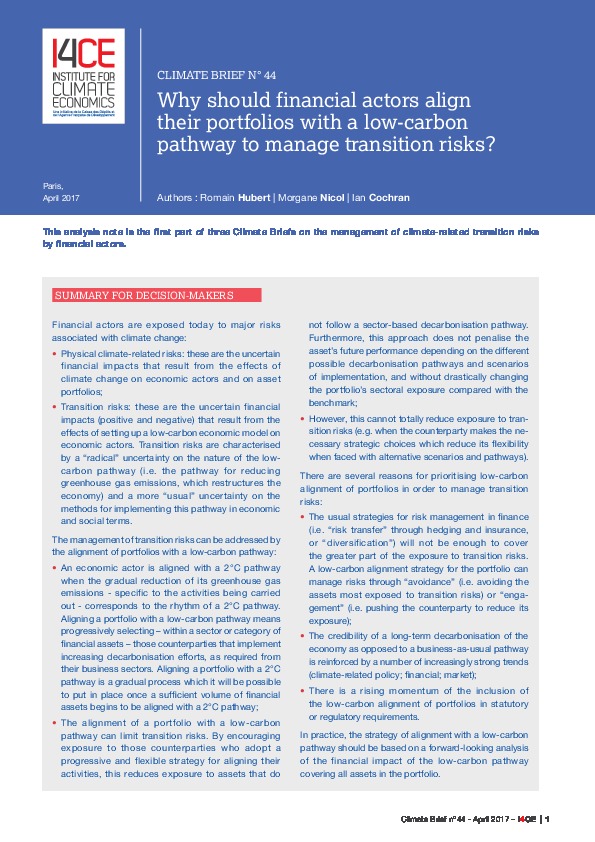Why should financial actors align their portfolios with a 2°C pathway to manage transition risks?
What does aligning a portfolio with a low-carbon pathway mean?
To limit global warming and its economic consequences, there is a limited “budget” for carbon that can be released into the atmosphere between now and the end of the century. A “low-carbon pathway” therefore refers to the pathway of an economy that is implementing efforts to sufficiently restructure its activities to significantly reduce greenhouse gas emissions. Among low-carbon pathways, the “2°C pathway” allows the achievement climate policy objectives, or a decarbonisation of the economy at a level that limits global warming below +2°C compared with the pre-industrial era.
In the context of a low-carbon pathway, each activity will see its carbon intensity progressively decrease, at a level and pace depending on its specificities and the technological breakthroughs occurring in its sector. An economic actor (who is the “counterparty” to a financial actor) is aligned with a low-carbon trajectory (respectively 2°C pathway) if the decrease in greenhouse gas emissions associated with its activity follows the rate – specific to the activities being carried out – that corresponds to a low-carbon pathway (respectively a 2°C pathway). An aligned company is not necessarily one that today draws a significant proportion of revenues from very low carbon intensity activities.
Aligning a portfolio with a low-carbon pathway therefore means choosing – within a sector or category of financial assets – those counterparties who are progressively beginning to implement the required decarbonisation efforts on their business sectors. Aligning a portfolio with a low-carbon pathway (and a fortiori with a 2°C pathway) is a gradual process that will only be possible to fully put into place once a sufficient volume of financial assets begins to be aligned with such a pathway.
In what way does aligning a portfolio with a low-carbon pathway constitute a management strategy for transition risks?
The alignment of a portfolio with a low-carbon pathway can limit transition risks, arising from the nature of the low-carbon pathway and the methods for implementing it. Encouraging exposure to those counterparties who adopt a progressive and flexible strategy for aligning their activities reduces exposure to assets that do not follow a sector-based decarbonisation pathway. Provided that the strategy of the counterparty remains flexible, its alignment does not penalise the asset’s future performance no matter the different possible decarbonisation pathways and scenarios of implementation. Since the alignment of the counterparty can be done for each activity, the alignment strategy of the financial actors does not drastically change the portfolio’s sectoral exposure compared with the benchmark.
However, this will not fully reduce exposure to transition risks (e.g. when the counterparty makes the necessary strategic choices which reduce its flexibility when faced with alternative scenarios and pathways).
Several reasons for prioritising the low-carbon alignment of portfolios to manage transition risks
- The usual strategies for risk management in finance (i.e. “risk transfer” through hedging and insurance, or “diversification”) will not be enough to cover the greater part of the exposure to transition risks. A low-carbon alignment strategy for the portfolio may limit more effectively the exposure to transition risks through “avoidance” (i.e. avoiding the assets most exposed to transition risks) or “engagement” (i.e. pushing the counterparty to reduce its exposure);
- The credibility of a long-term decarbonisation of the economy as opposed to a business-as-usual pathway is reinforced by a number of increasingly strong trends (climate-related policy; financial; market);
- There is a rising momentum of the inclusion of the low-carbon alignment of portfolios in statutory or regulatory requirements.

